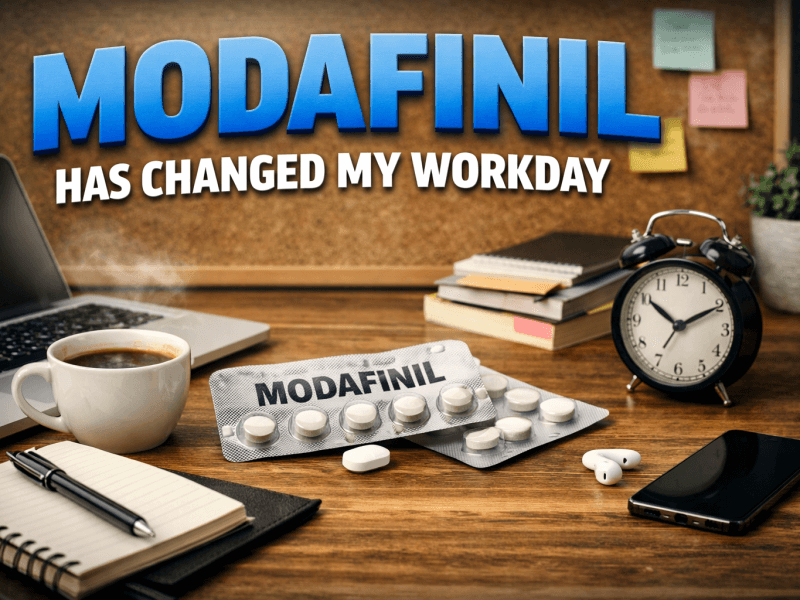Last Updated on 15/08/2025 by James Anderson
Introduction
Modafinil has gained popularity as a wakefulness-promoting agent, often prescribed for narcolepsy, shift work sleep disorder, and excessive daytime sleepiness. However, like any medication affecting the central nervous system, it can have side effects. One of the less common but potentially distressing side effects is the occurrence of modafinil induced panic attacks.
While panic attacks can be alarming, understanding their frequency, symptoms, and prevention strategies can help users manage their experience and continue benefiting from the drug safely. This article provides an in-depth look into how modafinil can trigger panic episodes, how often it happens, and what you can do to prevent it.
Understanding Modafinil
Modafinil is classified as a eugeroic a medication that promotes wakefulness without the strong stimulant profile of amphetamines. It works by modulating various neurotransmitters, such as dopamine, norepinephrine, histamine, and orexin, which together increase alertness and cognitive performance.
Although modafinil is generally well-tolerated, its influence on brain chemistry can, in rare cases, contribute to heightened anxiety or even full-blown panic attacks.
What Is a Panic Attack?
A panic attack is a sudden onset of intense fear or discomfort that peaks within minutes. Common symptoms include rapid heartbeat, sweating, trembling, shortness of breath, and a feeling of impending doom.
Panic attacks are not always linked to psychological disorders sometimes they result from physiological changes in the body, such as those induced by medications like modafinil.
How Modafinil Affects the Brain
Modafinil increases dopamine levels by inhibiting its reuptake, leading to prolonged stimulation of dopamine receptors. It also enhances norepinephrine and histamine release, which heightens arousal.
While these effects improve focus and wakefulness, they can also over-activate the body’s “fight or flight” response in susceptible individuals, triggering anxiety or panic episodes.
Frequency of Panic Attacks in Modafinil Users
Research and anecdotal reports suggest that panic attacks from modafinil are rare, occurring in less than 1% of users. However, the risk may be higher in people with pre-existing anxiety disorders, high doses, or sensitivity to stimulants.
In a 2020 pharmacovigilance review, panic attacks were noted as an uncommon but significant adverse event, with higher prevalence in first-time users or those who rapidly increased their dosage.
Common Symptoms of Modafinil-Induced Panic Attacks
- Sudden onset of intense anxiety
- Rapid heart rate (tachycardia)
- Shortness of breath
- Sweating and chills
- Dizziness or lightheadedness
- Trembling
- Sense of detachment or unreality
- Feeling of impending doom
Early Warning Signs to Watch For
Catching symptoms early can help prevent a full panic episode. Warning signs may include:
- Restlessness or unusual irritability
- Elevated heart rate without exertion
- Tingling sensations in hands or face
- Feeling unusually “on edge”
- Trouble concentrating despite high alertness
Causes and Risk Factors
Several factors can make panic attacks more likely when using modafinil:
Psychological vs. Physiological Triggers
- Psychological: Pre-existing anxiety, PTSD, depression
- Physiological: Rapid neurotransmitter shifts, dehydration, poor sleep, caffeine overuse
Dosage-Related Risks
Higher doses (above 200 mg daily) increase the risk of overstimulation and anxiety, particularly in new users.
Strategies for Prevention
To reduce the risk of panic attacks while on modafinil:
Lifestyle Adjustments
- Maintain good hydration
- Get adequate sleep
- Avoid combining with excessive caffeine
- Practice mindfulness or meditation
Safe Dosage Practices
- Start with the lowest effective dose
- Avoid abrupt dose increases
- Take modafinil earlier in the day to prevent sleep disruption
Coping Mechanisms During a Panic Attack
If a panic attack occurs:
- Sit or lie down in a calm environment
- Focus on slow, deep breathing (inhale 4 sec, exhale 6 sec)
- Remind yourself that the episode will pass
- Engage in grounding techniques (touch an object, describe surroundings)
When to Seek Medical Help
Seek immediate help if panic attacks:
- Occur frequently or severely
- Are accompanied by chest pain or fainting
- Interfere with daily functioning
- Are linked to dangerous behaviors (driving during an episode)
Long-Term Outlook for Modafinil Users
With proper dose management and lifestyle adjustments, most users can avoid panic attacks entirely. For those who experience recurring issues, discussing alternatives with a healthcare provider is recommended.
FAQ
1. Can modafinil cause panic attacks in healthy individuals?
Yes, although rare, modafinil can trigger panic attacks even in people without prior anxiety disorders.
2. How can I tell if my panic attack is from modafinil?
If symptoms began soon after starting or increasing your dose, modafinil may be the cause.
3. Is reducing the dose enough to stop panic attacks?
Often, yes. Many users find relief after lowering their dose.
4. Can I take modafinil with anti-anxiety medication?
Only under medical supervision, as drug interactions are possible.
5. Are there non-drug alternatives to modafinil?
Yes, options include regular exercise, proper sleep hygiene, and nootropic supplements like L-theanine.
6. Does caffeine make panic attacks more likely on modafinil?
Yes. Caffeine can amplify stimulation, increasing the risk of anxiety or panic.
Conclusion
While modafinil-induced panic attacks are rare, they can be distressing for those affected. By recognizing early symptoms, adhering to safe dosage guidelines, and adopting supportive lifestyle habits, most users can continue to benefit from modafinil without significant anxiety issues.
‼️ Disclaimer: The information provided in this article about modafinil is intended for informational purposes only and is not a substitute for professional medical consultation or recommendations. The author of the article are not responsible for any errors, omissions, or actions based on the information provided.
References:
- Hersey M, Tanda G. Modafinil, an atypical CNS stimulant? Pharmacological Advances in Central Nervous System Stimulants. Adv Pharmacol. 2024
- Oliva Ramirez A, Keenan A, Kalau O, Worthington E, Cohen L, Singh S. Prevalence and burden of multiple sclerosis-related fatigue: a systematic literature review. https://doi.org/10.1186/s12883-021-02396-1 . 2021.
- Ciancio A, Moretti MC, Natale A, Rodolico A, Signorelli MS, Petralia A. Personality Traits and Fatigue in Multiple Sclerosis: A Narrative Review. Journal of Clinical Medicine. https://doi.org/10.3390/jcm12134518 . 2023
- Mereu, M., Bonci, A., Newman, A. H., & Tanda, G. The neurobiology of modafinil as an enhancer of cognitive performance and a potential treatment for substance use disorders. https://doi.org/10.1007/s00213-013-3232-4 . 2013
- U.S. Food and Drug Administration. PROVIGIL. U.S. Department of Health and Human Services. https://www.accessdata.fda.gov/drugsatfda_docs/label/2015/020717s037s038lbl.pdf . 2015
- Ballon JS, Feifel D. A systematic review of modafinil: potential clinical uses and mechanisms of action. J Clin Psychiatry. 2006
- Willavize, S. A., Nichols, A. I., & Lee, J. Population pharmacokinetic modeling of armodafinil and its major metabolites. https://doi.org/10.1002/jcph.800 . 2016
- ADHD: Clinical practice guideline for the diagnosis, evaluation, and treatment of attention-deficit/hyperactivity disorder in children and adolescents. https://www.ncbi.nlm.nih.gov/pubmed/22003063. 2011
- Arnold, V. K. A 9-week, randomized, double-blind, placebo-controlled, parallel-group, dose-finding study to evaluate the efficacy and safety of modafinil as treatment for adults with ADHD. Available at: https://www.ncbi.nlm.nih.gov/pubmed/22617860. 2012


